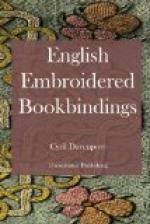On the tomb of Prince Arthur, son of Henry VII., at Worcester, the feather is shown both singly and in plume, and it occurs in the triple plume form within a coronet and a scroll with the words ’ICH DIEN’ upon it, on bindings made by Thomas Berthelet for Prince Edward, son of Henry VIII., who never was Prince of Wales.
It really seems as if the first ‘Prince of Wales’ actually to use the ostrich feather plumes as a personal badge of that dignity was Prince Henry, and it occurs largely on such books belonging to his library as he had rebound, and also on books that were specially bound for presentation to him.
This is the case in one of the most decorative bindings he possessed, enclosing a collection of tracts originally the property of Henry VIII., but which somehow or other became the property of Magdalen College, Cambridge, the governing body of which had it bound in embroidered velvet and presented to Prince Henry.
[Illustration: 30—Bacon, Opera. Londini, 1623.]
The cover is of crimson velvet, the edges of which extend freely beyond the edges of the book, bound all round with a fringe of gold cord. It measures about 8 by 6 inches. The design is the same on each side. In the centre is a large triple plume of ostrich feathers, thickly and beautifully worked in small pearls, within a golden coronet, and having below them the motto ‘ICH DIEN’ in gold upon a blue silk ribbon.
The badge is enclosed in a rectangular panel of gold cords, in each corner of which is an ornamental spray of gold cords, guimp, and a flower in pearls. A broad border with a richly designed arabesque of gold guimp or cord, with pearl flowers, encloses the central panel. The design is filled in freely with small pearls enclosed in guimp circles and small pearls alone.
The back has an ornamental design in gold cord and guimp. This cover is a beautiful specimen of later decorative work on velvet, and the general effect is extremely rich, the design and workmanship being equally well chosen as regards the materials to which they are applied, and with which they are worked.
Bacon, Opera. Londini, 1623.
A copy of the works of Francis Bacon, Viscount St. Albans, printed in London in 1623, is bound in rich purple velvet, and measures 13-1/4 by 8-3/4 inches. The design is a central panel with arabesque centre and corners, surrounded by a deep border of close curves and arabesques, all worked in gold cord and guimp. There are several gold spangles used, kept down by a small piece of gold guimp. The front edges of each board have only the marks left where two ties originally were, and the edges of the book are simply gilt.
[Illustration: 31—Bacon, Essays. 1625.]
Bacon, Essays. 1625.




